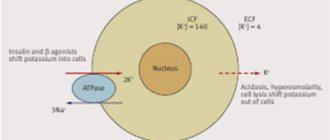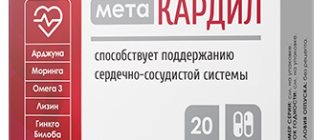Antihypertensives (from other gr. hypo decrease and lat. tensio tension, pressure) are medications that lower blood pressure and are used primarily for the treatment of hypertension. Therefore, they are also called antihypertensive drugs.
Arterial hypertension is distinguished as primary (hypertension or essential hypertension) and secondary (symptomatic).
The causes of hypertension are not completely known. An important role in the development of the disease is played by prolonged psycho-emotional stress, chronic stress, age-related decrease in vascular elasticity, excessive consumption of table salt and a sedentary lifestyle.
Secondary (symptomatic) arterial hypertension occurs due to an adrenal tumor. The tumor secretes large amounts of adrenaline, which is released into the blood, causing an increase in blood pressure. Also, symptomatic arterial hypertension can occur with kidney disease. In such cases we talk about renoprival hypertension. Secondary hypertension can be a symptom of other diseases.
Classification of antihypertensive drugs
Blood pressure is maintained by several physiological mechanisms: peripheral vascular resistance, heart rate and circulating blood volume. Antihypertensives usually affect one or more mechanisms of blood pressure maintenance.
Drugs that reduce the activity of the sympathetic nervous system
- Central type of action (clonidine, methyldopa, guanfacine, moxonidine)
- Beta-blockers (metoprolol, nebivolol, bisoprolol, atenolol, betaxolol, talinolol, carvedilol)
- Alpha blockers (prazosin, doxazazin, terazosin)
- Gagnlioblockers (hexamethonium benzosulfonate, azamethonium bromide, etc.)
Peripheral vasodilators (peripheral vasodilators)
- Angiotensin-converting enzyme inhibitors (enalapril, lisinopril, ramipril, captopril, perindopril, moexipril, spirapril)
- Angiotensin II receptor antagonists (valsartan, irbesartan, losartan, telmisartan, eprosartan)
- Calcium ion antagonists (nifedipine, amlodipine, lacidipine, isradipine, verapamil, diltiazem)
- Antispasmodics of myotropic type of action (papverine, bendazole)
Agents affecting water and electrolyte balance
- Diuretics (hydrochlorothiazide, indapamide, torsemide, chlorthalidone, spironolactone)
In addition to the drugs listed in the classification, blood pressure can be lowered by drugs that reduce psycho-emotional stress. For example, sedatives or tranquilizers.
Basics of treatment of hypertension
Arterial hypertension is a dangerous disease that requires treatment. High blood pressure damages the vessels of the brain, heart and kidneys, overloads the heart, and leads to the progression of atherosclerotic changes in blood vessels. These disorders lead to heart failure and so-called cardiovascular disasters - stroke and heart attack.
When treating arterial hypertension, one always strives to act primarily on the cause that causes it. If the cause is unknown or cannot be eliminated, symptomatic treatment is performed.
The main goal of treating hypertension is to reduce blood pressure to the so-called target (safe) numbers. Most experts in the field of cardiology consider systolic (upper) pressure above 140 mm dangerous. rt. Art.
The selection of an antihypertensive drug by a doctor is usually carried out empirically (experimentally). One of the so-called drugs of choice is prescribed in a minimum dose with constant monitoring of blood pressure. If the selected dose is ineffective, it is increased to the next dose of this drug. If the target blood pressure figures cannot be achieved, a second antihypertensive drug with a different mechanism of action and a different point of application of physiological blood pressure maintenance is prescribed in parallel. This type of therapy for hypertension is called combination therapy.
Rational combinations of antihypertensive drugs
Lecture transcript
XXVI All-Russian Educational Internet Session for doctors
Total duration: 20:10
Oksana Mikhailovna Drapkina, executive director of the Internet Session, secretary of the interdepartmental council on therapy of the Russian Academy of Medical Sciences: - It is with great pleasure that I give the floor to Professor Maria Genrikhovna Glezer. "Rational combinations of antihypertensive drugs"
00:10
Glezer Maria Genrikhovna, Doctor of Medical Sciences:
– Dear colleagues. Arterial hypertension is currently the No. 1 risk factor. In 2010, it was recognized by the World Health Organization as the No. 1 killer. It is high blood pressure that determines more than 50% of all cases of coronary heart disease and strokes.
What are the classes of drugs for long-term treatment of arterial hypertension. 8 classes. But we must first use the first 5 classes:
- diuretics;
- beta blockers;
- ACE inhibitors;
- sartans;
- calcium channel blockers.
Alone or in combination, these drugs are used to reduce the risk of complications.
There is a sufficient evidence base for these first five drugs. These classes of drugs may reduce cardiovascular morbidity and death.
What are the main pathophysiological mechanisms involved in increased blood pressure?
This is the activation of the renin-angiotensin system. Activation of the sympathetic nervous system. Increase in circulating blood volumes (changes in water and electrolyte balance).
Ultimately, these systems will lead to changes in intracellular calcium transport. The drugs that we have affect different stages of pathogenesis.
Beta blockers, sympatholytics, imidazoline receptor agonists - for increased activity of the sympathetic nervous system. Diuretics – for increased circulating blood volume, lipid metabolism disorders. Calcium antagonists – to change intracellular calcium transport. 3 groups of drugs (inhibitors, sartans and direct renin inhibitors) - on the activated rhinin-angiotensin system.
We know well from clinical practice that all patients with arterial hypertension are different. The contribution of each pathogenetic mechanism may vary from person to person. For some, an increase in circulating blood volume prevails. Some people have predominantly increased activity of the renin-angiotensin system. Some people (especially young people) experience an increase in the activity of the sympathetic nervous system.
It is clear that it is most often impossible to solve the problem with one class of drugs.
02:34
Athena Study.
More than 2,000 women in the Russian Federation were analyzed. Where hypertension was controlled, 2-component, 3-component or more drugs were more often used to treat high blood pressure.
Where there was no control (in fact, this was the majority), either these patients were not treated at all, or monotherapy was used. This is further evidence that different classes of drugs need to be combined in order to achieve blood pressure goals.
Categories of patients most likely to require combination therapy:
- persons who have a significant increase in blood pressure (above 160/100 mm Hg);
- patients with diabetes mellitus (DM);
- people who have certain lesions of organ systems. For example, kidney damage;
- left ventricular hypertrophy (LVH);
- people who smoke, are obese, have sleep disordered breathing.
Combination therapy is the key to success in achieving the goal (based on the pathogenetic mechanisms that I have already mentioned and the complications that often occur in patients).
What do we call a goal? The best evidence to date is that the goal is to achieve target blood pressure values.
In September 2010, there were some changes to the target values. Now, regardless of the degree of risk, they try to keep the pressure below 140 and 130. Up to 140 mm Hg. Art. systolic and 90 – 80 mm Hg. Art. by diastolic.
Not a single large study (probably how they were structured) has proven that a decrease of less than 130 and 80 mm Hg. Art. provides an additional reduction in morbidity and mortality. At the same time, a decrease from 130 is a very difficult moment, requiring a lot of effort and financial costs.
In persons over 80 years of age, based on data from the HYVET study, target values for systolic pressure are set at less than 150 mmHg. Art. Low numbers remain with significant proteinuria.
05:04
A meta-analysis of 147 studies in older people aged 60–69 years showed that while one standard-dose drug reduces the risk of coronary heart disease by 25% and stroke by 35%, then a combination of three drugs at half the dosage reduces the risk of developing both coronary heart disease and stroke is almost twice as high.
A very interesting analysis was published in 2009. A 2-drug combination has been shown to be 5 times more effective in lowering systolic blood pressure (SBP) than doubling the dose of either drug class. Be it beta blockers, diuretics, inhibitors, calcium antagonists. This is proof that it is combination therapy that allows you to achieve the desired values.
In addition, combination therapy can undoubtedly lead to a faster, more pronounced reduction in blood pressure.
The VALUE study clearly showed: if during the first month from the start of treatment the pressure decreases by more than 10 mm Hg. Art., then the number of fatal/non-fatal cardiovascular events, strokes and death from all causes becomes significantly less than in those people who did not achieve a reduction during the first month.
06:29
The second point that you should pay attention to: you should still strive to achieve the target numbers within 6 months. This is less than 140 mmHg. Art. Then all outcomes, including fatal events, heart attacks, strokes, deaths from all causes, and hospitalization will be significantly lower.
In my opinion, how should the decision-making process proceed when treating patients with arterial hypertension.
Certainly. We can start with monotherapy. This ensures the safety of treatment for our patients. If you see a person for the first time and you do not know what the reaction will be to antihypertensive therapy, you can start with monotherapy.
But you don’t need to go further in this vicious circle: you reached the maximum increase in dose, you became convinced that it was ineffective, you changed the drug, and so on. Patients stop this treatment, they leave the doctor.
Correct decision-making process: Tried monotherapy. We realized that it was quite effective and safe, and switched to combination therapy. We are moving further along the path of increasing doses of combination drugs. This is the principle I preach.
Plus one: the patient came - the treatment was not effective enough - the next class of drugs was added. If something else doesn’t suit you, the next class is added. Then you will be more likely to succeed.
When it comes to combination therapy, they always say: “This is polypharmacy, it is bad for patients, and so on.” Correct, because combination therapy must undoubtedly be rational.
What is rational therapy? This is when the effectiveness of treatment increases, while the incidence of side effects decreases.
This can lead to an increase in efficiency. We use different classes of drugs, influence different parts of the pathogenesis of the disease and eliminate the activation of counter-regulatory systems. If you use drugs in smaller dosages, then dose-related side effects may, of course, be reduced.
The side effects of one of the components can be eliminated by using another component.
08:51
Recommended combinations of drugs for hypertension.
Diuretics plus inhibitors or sartans. Best time to use: Where there is a high risk of heart failure.
Beta blockers and dihydropyridine calcium antagonists. When is it best to use: for ischemic heart disease.
Metabolically neutral class of drugs, sartan inhibitors, calcium antagonists. In persons at high metabolic risk.
Today, this is probably how one can imagine rational combinations. It's a diuretic plus something. Anything – these are inhibitors or sartans.
Another type of combination. Calcium antagonists plus ACE inhibitor or calcium antagonists plus sartans. Dihydropyridine calcium antagonists are used with beta blockers in patients with coronary artery disease.
Currently, the combination of diuretics plus calcium antagonists is considered irrational because this combination almost doubles the risk of myocardial infarction. Diuretics plus beta blockers had the best effect in this case.
The final picture looks like this: 1) calcium antagonists plus inhibitors or sartans and 2) diuretics, inhibitors and sartans.
The slide shows the recommended combinations of antihypertensive drugs in a trapezoid.
This trapezoid is considered the most rational today.
I took the liberty of slightly modifying the picture shown in the European recommendations. I drew a triangle. At the top I put a group of drugs that inhibit the activity of the renin-angiotensin system (RAS) plus diuretics or plus calcium antagonists. Or the three of us together in the center of the class. There will be effective treatment.
What is the rationale for saying that a combination of diuretics, inhibitors or sartans is an effective and rational combination. It is known that diuretics and inhibitors (sartans) are powerful antihypertensive drugs with pronounced organoprotective properties that can reduce the incidence of morbidity and mortality in arterial hypertension (AH).
The enhancement of the hypotensive effect is due to the fact that conditions are created for the most pronounced action of both components. The activation of counter-regulatory mechanisms is eliminated: diuretics reduce sodium levels, thereby stimulating the production of renin. This leads to a more pronounced antihypertensive effect of drugs that inhibit the activity of the angiotensin system.
At the same time, inhibitors or sartans, by reducing the production of aldosterone, reduce the excretion of potassium from the body, which is always not good when prescribing diuretics. In addition, inhibitors and sartans have a beneficial effect on purine metabolism and reduce the severity of hyperuricemia.
11:50
The combination with diuretics allows you to achieve the same reduction in blood pressure 4 weeks earlier compared to monotherapy with any of the drugs. This leads to the fact that better treatment results can be achieved.
ACE inhibitors (in general, probably the same with sartans) are drugs with pronounced organotensive properties. They influence vascular remodeling, reducing or normalizing the ratio between the lumen of blood vessels and the intima-media complex. This is very important for persistently maintaining blood pressure at normal levels and avoiding crises. The data are given for one of the long-acting ACE inhibitors - the drug Lisinopril. In our country it is often used in the form of the drug “Diroton”. Normalization of the vascular ratio in arterial hypertension.
Indicators related to heart function improve. In particular, improving the diastolic function of the heart. The ratio of peak E to peak A returns to almost normal. The time of isovolumic relaxation improves, the diameter of cardiomyocytes decreases. It is very important that myocardial fibrosis is reduced in patients with arterial hypertension. This is one of the first steps to developing a particular form of heart failure. Heart failure, which is caused by hypertension with preserved ejection fraction.
13:27
ACE inhibitors are known to work very well in obesity because the activity of the renin-angiotensin system is increased in obesity. Each fat cell produces the angiotensin gene in an amount equal to 70 liver cells.
One of the first studies that was conducted demonstrated that lisinopril was effective in approximately 60 patients. Hydrochlorothiazide (HTC) is less effective. The most important thing is that this effect is detected at doses of “Lisinopril” of 10 mg, and “Hydrochlorothiazide” - 50 mg. The side effects of Hydrochlorothiazide may already be quite pronounced.
A very interesting study was conducted in Russia - the Desire study. This study showed that the use of lisinopril can normalize the abnormal daily blood pressure profile. In particular, Lisinopril in women halved the night-picker type when there is a sharp increase in blood pressure at night.
Another achievement that was shown in this study. The use of the drug in the evening allows to normalize blood pressure to a greater extent and reduce the disturbed profile. This is important because night-pickers have a higher incidence of strokes, adverse events, and so on.
Combination with diuretics. Diuretics are one of the most important classes of drugs for the treatment of arterial hypertension. Returning to the Athena study, I would like to say that the difference is in the prescription of drugs where it was ineffective: diuretics were used less often. All other classes were used approximately equally. If diuretics are not prescribed, then it is even difficult to say that something is effective or ineffective.
15:22
Two studies: UKPDS and LIFE. In the UKPDS study, the target blood pressure was 160/90 mmHg. Art. 60% of patients were already on diuretics. In the LIFE study, where the target numbers were 140/90 mmHg. Art. 90% of patients required diuretics.
In our country, the use of diuretics is somewhere around 30%. This is not a sufficient purpose. According to the LIFE study, people who received diuretic drugs had a 30-40% lower risk of various adverse events (cardiovascular death, heart attack, stroke), and a 45% lower overall mortality rate. This is a very important class of drugs that should be used in combination therapy.
I'll say it again. We can say that hypertension is resistant to treatment if a combination of three antihypertensive drugs prescribed in adequate dosages does not reduce blood pressure, but one of these drugs is a diuretic. Thus, this is a very important way to achieve target blood pressure values.
The use of ready-made combination forms is an easier path to success in treating patients with arterial hypertension.
Where hypertension was controlled, a higher percentage of cases used preformed combination dosage forms than in groups where there was no sufficient effect.
I want to show you one more study. Where a combination of Lisinopril and Hydrochlorothiazide was used (in our country, the drug Co-Diroton), patient adherence to treatment was higher than when Lisinopril and Hydrochlorothiazide were used in 2- x different tablets.
The creation of finished dosage forms follows the path of rational combinations, that is, a diuretic plus an ACE inhibitor, or a diuretic plus sartan. Or a combination based on calcium antagonists, to which inhibitors, sartans or beta blockers are added in the treatment of patients with coronary heart disease.
Now a drug has been released that contains a combination of 3 groups. This is Amlodipine plus Valsartan plus Hydrochlorothiazide. This is the right direction: when you have selected certain dosages, then you can already use ready-made combined forms.
In a nutshell about the combination of calcium antagonists with inhibitors or sartans. Calcium antagonists are good at reducing the risk of stroke, inhibitors are good at reducing the risk of myocardial infarction. This provides a reduction in the risk of major cardiovascular events.
18:14
Advantages and disadvantages of mono- and combination therapy for arterial hypertension.
Of course, if you use combination therapy, there is always a higher response rate. This is a very high possibility of dose titration, because you can take a quarter of a tablet from one package, a full tablet from another, and so on. The incidence of side effects is lower if we use rational combinations.
But it becomes difficult to accept. Patients with hypertension will not use anything that is complicated. As soon as the necessary dosages have been selected, you need to switch to fixed combinations, which has an advantage in absolutely all positions.
In conclusion, I want to say what rational combination antihypertensive therapy is. This is an impact on different parts of the pathogenesis of hypertension and elimination of the activation of counter-regulatory mechanisms. Based on this, the effectiveness of treatment increases. When it is effective, people will be more committed (commitment increases).
A good combination is a decrease in the frequency of side effects - which means an increase in adherence. Increasing adherence means increasing the effectiveness of treatment.
Let's look at the second part of this circle. Increasing efficiency, increasing adherence means decreasing cost. Any change in therapy entails, of course, an increase in the cost of treatment. And when it’s not so expensive, people will be more committed. They will better follow the doctor's orders. You should always think about this.
Thank you for your attention.
Oksana Drapkina: Thank you very much, Maria Genrikhovna.
Features of the treatment of hypertension
Therapy for hypertension is not carried out periodically, but with the constant use of an antihypertensive drug.
It is an extremely dangerous misconception to use the drug only “when there is pressure.” If hypertension is diagnosed, there is a tendency for a persistent increase in systolic pressure above 140 mm. rt. Art., an antihypertensive drug is taken daily, preferably at the same time, under constant monitoring of blood pressure, for life.
Antihypertensive therapy: general rules
Both symptomatic hypertension and hypertension require correction with drugs that have a hypotensive effect. Antihypertensive therapy can be carried out with drugs that differ in their mechanism of action: antiadrenergic agents, vasodilators, calcium antagonists, angiotensin antagonists, and diuretics.
You can obtain information about the hypotensive effect of the drug and what medications to take for high blood pressure not only from your doctor, but also from your pharmacist.
Arterial hypertension is a chronic disease that requires constant drug support, daily monitoring and regular use of prescribed medications. Not only the state of health, but also the life of a person depends on compliance with these rules.
Despite the general availability of treatment rules for reducing blood pressure, many patients have to be reminded what a treatment regimen for hypertension should look like:
- Antihypertensive medications should be taken regularly, regardless of the patient’s well-being and blood pressure level. This allows you to increase the effectiveness of blood pressure control, as well as prevent cardiovascular complications and target organ damage;
- It is necessary to strictly adhere to the dosage and use the form of the drug prescribed by the attending physician. Independently changing the recommended dose or replacing the drug may distort the hypotensive effect;
- even if you are constantly taking antihypertensive drugs, it is necessary to systematically measure blood pressure, which will allow you to evaluate the effectiveness of therapy, timely identify certain changes and adjust treatment;
- in the case of an increase in blood pressure against the background of constant antihypertensive treatment - the development of an uncomplicated hypertensive crisis, an additional dose of a previously taken long-acting drug is not recommended. Blood pressure can be quickly reduced using short-acting antihypertensive drugs.








